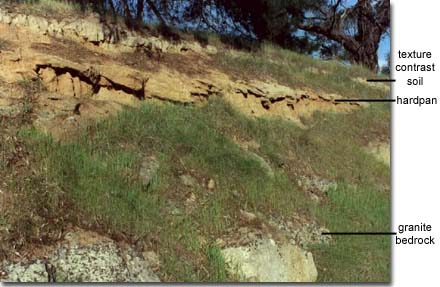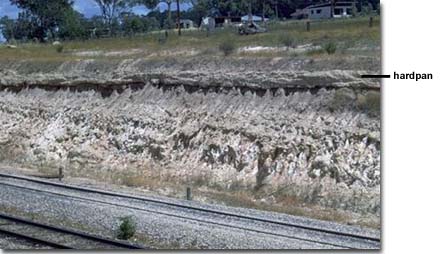Hardpans in Victoria
There has not been a systematic study of hardpans in Victoria, despite the fact that various forms of pedogenic hardpan are common and widespread. Hardpans appear as erosion-resistant formations in many road cuttings in areas of granitic parent-materials, such as along the Western Highway at Langhi Ghiran near Ararat and near Stawell. Similar formations can be seen in the road cuttings through the Harcourt granite, south of Bendigo. The existence of silicified, ferruginous and calcareous hardpans in northern and central Victoria were recognised both by Lorimer and Rowan (1982), and Lorimer and Schoknecht (1987).
 Hardpan in soil profile near Harcourt. | |
Cockroft (1965) described cemented hardpans in soils from the Goulburn Valley and noted that they are generally formed in coarse fluvial sediments which are overlain by clayey sediments of predominantly aeolian origin. He also found fragipans which are stratigraphically younger hardpans that are not cemented and become soft on wetting. The older hardpans are more resistant and impede drainage. On the basis of the stratigraphy and the characteristics of the overlying clays, he suggested that the cemented materials are probably prior-stream sediments from the Katandra period or earlier (Butler 1958), and the aeolian clays are Widgelli parna (Butler ibid.).
 Glenrowan railway cutting showing hardpans. | |
In northeastern Victoria, the railway cutting above exposes both a single hardpan layer some 0.5-1.0 m thick and a complex multi-layered formation in alluvial-colluvial sediments derived from the Glenrowan granite. On the southern side of the cutting, the surface half metre or so of the granite saprolite has been indurated. The indurated layer has a coarse orange-red and grey mottle pattern which suggests that lateritic weathering preceded the induration process. At the eastern end of the cutting, similarly mottled sediments occur beneath the body of sediment in which the hardpan has developed.
Though chemical data on Victorian hardpans are largely lacking, they do not appear to be as hard or sufficiently silicified to justify calling them silcretes. The term duricrust or duripan is probably appropriate for at least some.


